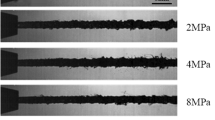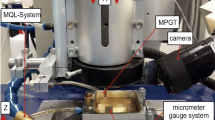Abstract
Abrasive suspension flow machining (ASFM) is an advanced finishing method that uses an abrasive suspension slurry for grinding and chamfering as well as the finishing of inaccessible components. This study examines the effect of back pressure on the grinding characteristics of an abrasive suspension flow during the grinding of slender holes. A numerical model was developed to simulate the abrasive suspension flow in a slender hole and was verified experimentally using injector nozzle grinding equipment under different grinding pressures and back pressures. It is shown that the ASFM with back pressure not only eliminates the cavitation flow in the spray hole, but also increases the number of effective abrasive particles and the flow coefficient. Increasing the back pressure during the grinding process can increase the Reynolds number of the abrasive suspension flow and reduce the thickness of the boundary layer in the slender hole. Moreover, increasing the back pressure can improve the flow rate of the injector nozzle and its grinding performance.















Similar content being viewed by others
References
Brar BS, Walia RS, Singh VP (2015) Electrochemical-aided abrasive flow machining (ECA2FM) process: a hybrid machining process. Int J Manuf Technol 79:329–342
Tsai FC, Yan BH, Kuan CY et al (2008) A Taguchi and experimental investigation into the optimal processing conditions for the abrasive jet polishing of SKD61 mold steel. Int J Mach Tools Manuf 48:932–945
Cai HX, Liu W (2017) A prediction method for the precision of extrusion grinding of a needle valve body. Prod Eng Res Devel 11:295–305
Fang MH, Yu T, Jeff X (2020) An experimental investigation of abrasive suspension flow machining of injector nozzle based on orthogonal test design. Int J Adv Manuf Technol 110:1071–1082
Qiu T, Song X, Lei Y et al (2016) Effect of back pressure on nozzle inner flow in fuel injector. Fuel 173:79–89
Payri R, Garcia JM, Salvador FJ et al (2005) Using spray momentum flux measurements to understand the influence of diesel nozzle geometry on spray characteristics. Fuel 84:551–561
He ZX, Zhong WJ, Wang Q et al (2013) Effect of nozzle geometrical and dynamic factors on cavitating and turbulent flow in a diesel multi-hole injector nozzle. Int J Therm Sci 70:132–143
Desantes JM, Payri R, Salvador FJ et al (2010) Influence of cavitation phenomenon on primary break-up and spray behavior at stationary conditions. Fuel 89:3033–3041
Som S, Ramirez AI, Longman DE et al (2011) Effect of nozzle orifice geometry on spray, combustion, and emission characteristics under diesel engine conditions. Fuel 90(3):1267–1276
Serras-Pereira J, Romunde Z, Aleiferis PG et al (2010) Cavitation, primary break-up and flash boiling of gasoline, isooctane and n-pentane with a real-size optical direct-injection nozzle. Fuel 89(9):2592–2607
Bai Y, Fan LY, Ma XZ et al (2016) Effect of injector parameters on the injection quantity of common rail injection system for diesel engines. Int J Automot Technol 17(4):567–579
Payri R, Gimeno J, Venegas O et al (2012) Effect of partial needle lift on the nozzle flow in diesel fuel injectors. Atomization Spray 22(8):687–714
Lee CH (2017) Effect of nozzle orifice diameter on diesel spray tip penetration according to various spray models for CFD simulation with widely varying back pressure. Int J Automot Technol 18(2):317–325
Singh S, Shan HS (2002) Development of magneto abrasive flow machining process. Int J Mach Tools Manuf 42:953–959
Hu GH, Zhu WH, Cai HX et al (2009) Mathematical model for abrasive suspension jet cutting based on orthogonal test design. J Shanghai Univ (Engl Edn) 13:37–44
Jain VK (2009) Magnetic field assisted abrasive based micro-/nano-finishing. J Mater Process Technol 209:6022–6038
Petare AC, Jain NK (2018) A critical review of past research and advances in abrasive flow finishing process. Int J Adv Manuf Technol 97:741–782
Pang KL, Nguyen T, Fan JM et al (2010) Machining of micro-channels on brittle glass using an abrasive slurry jet. Key Eng Mater 443:639–644
Wang J, Nguyen T, Pang KL (2009) Mechanisms of microhole formation on glasses by an abrasive slurry jet. J Appl Phys 105(4):1274–1277
Tzeng HJ, Yan BH, Hsu RT et al (2007) Self-modulating abrasive medium and its application to abrasive flow machining for finishing micro channel surfaces. Int J Adv Manuf Technol 32:1163–1169
Pang KL, Nguyen T, Fan JM et al (2012) Modelling of the micro-channelling process on glasses using an abrasive slurry jet. Int J Mach Tools Manuf 53:118–126
Zhou X, Xi F (2002) Modeling and predicting surface roughness of the grinding process. Int J Mach Tools Manuf 42:969–977
Wang AC, Liu CH, Liang KZ et al (2007) Study of the rheology and the finishing behavior of abrasive gels in abrasive flow machining. J Mech Sci Technol 21:1593–1598
Author information
Authors and Affiliations
Corresponding author
Rights and permissions
About this article
Cite this article
Fang, MH., Yu, T. & Xi, FF. Effect of back pressure on the grinding performance of abrasive suspension flow machining. Adv. Manuf. 10, 143–157 (2022). https://doi.org/10.1007/s40436-021-00372-z
Received:
Revised:
Accepted:
Published:
Issue Date:
DOI: https://doi.org/10.1007/s40436-021-00372-z




